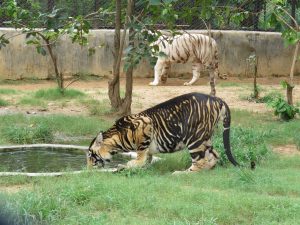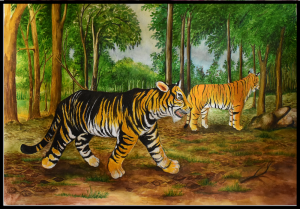Although we have all probably heard the idiom that lions are the king of the jungle, tigers take the title of largest living cat species. Tigers are most recognizable for their coats having dark vertical stripes on a light background of white, gold, or orange.
India is home to two-thirds of the world’s tigers. Although conservation groups in India have made much progress in recovering endangered tiger populations, several small, isolated populations of tigers still exist there. It was in one of these small populations that scientists discovered rare black tigers—a discovery that helped add to the genetic knowledge about coat color patterns in mammals. These black tigers also revealed important insights into the effect of small, isolated populations on Earth’s declining biodiversity.
Tiger stripes as a model to study genetic variation in small population

A captive pseudomelanistic tiger at Nandankanan Biological Park, Bhubaneswar, India; Photo captured by Dr. Rajesh Kumar Mohapatra, Biologist, Nandanakana Biological Park
Inbreeding in small, isolated populations leads to low levels of genetic variation amongst members and puts them at high risk for extinction. The small gene pool means that rare or harmful genetic variants are more likely to become prevalent in such populations, compared to populations with open gene flow. However, there are few genetic studies of small, isolated populations in which change in appearance is associated with trackable genetic variants.
Over the course of several years, camera traps at the Similipal Tiger Reserve in eastern India caught images of a few rare tigers that appeared to be mostly black. This phenomenon, known as pseudomelanism, occurs when the dark stripes on the tiger are broadened so much that they fuse together.
Chris Kaelin, PhD and Greg Barsh, MD, PhD, from the HudsonAlpha Institute for Biotechnology were part of a team, led by Vinay Sagar and Uma Ramakrishnan, PhD, from Bangalore’s National Center of Biological Sciences, that set out to study the genetic basis of the rare stripe pattern in these tigers. Because the pseudomelanistic tigers live in a small population, this gave the team a unique opportunity to study a rare trait in a small population. The results from the study were published in PNAS.
Taqpep mutation influences tiger stripes in small population
Color markings among cat species display remarkable diversity. Calico and tortoiseshell cats have random stripes of varying colors while cheetahs have rosette patterns and tabby cats and tigers have predictably patterned and colored stripes. Barsh and Kaelin are no strangers to the felines, having studied coat patterns in cats ranging from housecats to Bengal cats. They previously discovered that variants in a gene called Transmembrane Aminopeptidase Q (Taqpep) are responsible for the blotched color patterns in tabby cats and the rare king cheetah coat pattern where spots merge into blotches and stripes.
“Because Taqpep mutations in domestic cats and cheetah alter pattern formation in a manner that is similar to pseudomelanistic tigers, we saw Taqpep as a strong candidate for pseudomelanism in tigers,” says Barsh.

A painting depicting the contrasting phenotype of a pseudomelanistic and a normal tiger; Painting by Deblina Sain Basu
Genome analysis of eight captive tigers revealed a single nucleotide variant in the Taqpep gene of all pseudomelanistic tigers. Further analysis indicated that the variant is a loss of function mutation in Taqpep, similar to mutations in other felines with unusual coat patterning. By constructing pedigrees of captive tigers, the team predicted that pseudomelanism in tigers is inherited as an autosomal recessive trait, meaning pseudomelanistic offspring must inherit one copy of the gene from each parent.
“We have no reason to think that dark colored tigers in Similipal are more successful than striped ones,” says Kaelin. “Instead, the high incidence of pseudomelanism likely reflects low genetic diversity of the Similipal population, a consequence of habitat fragmentation and lack of connectivity to other populations.”
Over the past 30 years, pseudomelanistic tigers have only been seen or camera trapped in Similipal. To determine if the pseudomelanistic gene variant is limited to Similipal, the team analyzed DNA from non-invasively collected fecal samples from wild populations of tigers. The pseudomelanistic variant was not detected in any other tigers that the researchers sampled.
“The opportunity to survey a phenotype in the wild with non-invasive genetic samples was very exciting,” says Sagar. “I spent several months in Similpal and never saw a tiger. But by using non-invasive testing we were able to understand the frequency of this mutation here.”
What are the implications of this study on efforts to maintain Earth’s biodiversity?
Biodiversity, the variety of living species on Earth, is important for our planet’s health because every single species has a role to play in the success of its habitat. Earth’s biodiversity is rich, with scientists estimating that there are between 3 and 30 million species on Earth, and a few studies predicting that there may be more than 100 million species on Earth. However, many species are being threatened with extinction due to human activities, putting the Earth’s magnificent biodiversity at risk.
Small and isolated populations such as Similipal are at a heightened threat of extinction due to low genetic diversity. Conservation practice recommends rescuing small populations by introducing new individuals with a different genetic background into the population.
“The genetic isolation of Similipal tigers is possibly due to human-induced habitat fragmentation,” says Ramakrishnan. “It will be important to explore options to enhance connectivity for Similipal Tiger Reserve in the future.”
As part of their study, the team modeled genetic rescue of the Similipal tiger population to determine how best to increase its genetic diversity. They estimate that bringing in one new tiger per generation would result in the loss of the pseudomelanistic mutation from Similipal and would benefit the population by reintroducing genetic diversity and decreasing problems from inbreeding.
“Our study highlights the importance of integrating genetics into the practice of endangered species protection,” says Barsh. “Combined analysis of non-invasive stool samples from wild individuals and blood or tissue samples from captive individuals can highlight any potentially isolated variants in small, captive populations.”
Researchers from Indian Institute of Science Education and Research (Tirupati, India), Laboratory for the Conservation of Endangered Species (Hyderabad, India), Nandankanan Biological Park (Bhubaneswar, India), World Wide Fund for Nature-India (WWF India), Foundation for Ecological Research, Advocacy and Learning (India), Wildlife Institute of India, Odisha Forest Department (Bhubaneswar, India), National Tiger Conservation Authority – Wildlife Institute of India Tiger Cell, Wildlife Institute of India, and State Forest Research Institute (India) were also involved in this work.
Byline: Sarah Sharman, PhD, Science writer
About HudsonAlpha: HudsonAlpha Institute for Biotechnology is a nonprofit institute dedicated to developing and applying scientific advances to health, agriculture, learning, and commercialization. Opened in 2008, HudsonAlpha’s vision is to leverage the synergy between discovery, education, medicine, and economic development in genomic sciences to improve the human condition around the globe. The HudsonAlpha biotechnology campus consists of 152 acres nestled within Cummings Research Park, the nation’s second largest research park. The state-of-the-art facilities co-locate nonprofit scientific researchers with entrepreneurs and educators. HudsonAlpha has become a national and international leader in genetics and genomics research and biotech education and fosters more than 45 diverse biotech companies on campus. To learn more about HudsonAlpha, visit hudsonalpha.org.
Media Contact:
Lara Burhenn
lburhenn@hudsonalpha.org
(256) 937-8210


